方案详情文
智能文字提取功能测试中
Attension@White Paper Surface and interfacial tension - How to select the best measurement method Author: Susanna Lauren, PhD, Biolin Scientific Surface and interfacial tension - How to select the best measurement method for your application? With a wide variety of surface and interfacial tension meas-urement methods available, it can be difficult to determinewhich one is best suited for your application. You have prob-ably already heard about force and optical tensiometers andmaybe also du Nouy rings and Wilhelmy plates, but why haveso many different techniques if the outcome is essentially thesame?As surface and interfacial tension measurements areutilized in many different applications, the samples studied arealso very different from one another. When selecting a meas-urement method, you need to consider the properties of yoursample as well as the application you are working with. With this white paper we would like to offer you a tool formethod selection. By asking some simple questions about yoursample and application, we can decide the best method foryou. Quick overview of measurement methods The most commonly used equilibrium surface and interfacial tensionmeasurement methods are du Nouy ring, Wilhelmy plate and pendantdrop, of which the first two use force tensiometers and the last one is anoptical method. Force tensiometer measurements are based on measuring the forcesexerted on a probe positioned at the liquid-gas or liquid-liquid interface.The probe is connected to a highly sensitive balance and the liquidinterface of interest is brought into contact with the probe. The forcesmeasured by the balance as the probe interacts with the surface of theliquid can be used to calculate the surface tension. The force dependson the following factors: size and shape of the probe, contact anglebetween the probe and the liquid, and the surface tension of the liquid.The size and the shape of the probe are easily controlled. Probes aretypically made of platinum which helps to ensure a zero-degree contactangle between the probe and the liquid to be studied. Two configura-tions of probes are commonly used; the du Nouy ring and the Wilhelmyplate. A platinum rod can also be used instead of a Wilhelmy plate whenthe sample volume is limited. Surface and interfacial tension measurements can be performed opticallyusing pendant drop shape analysis. The shape of the drop hanging froma needle is determined from the balance of forces, which include thesurface tension of the liquid being investigated. Modern computationalmethods using iterative approximations allow for solutions of theYoung-Laplace equation to be found. Thus, the surface or interfacialtension between any two immiscible fluids with known densities can bedetermined.* *For more information on surface and interfacial tensions and their measurement methods, pleasesee our white paper titled "Surface and interfacial tension-what is it and how is it measured?". Questions to ask when selecting themeasurement method To select the best method for your application, there are few thingsthat need to be considered. Below, we have gathered some simplequestions for you to answer to facilitate the selection of the method. Do you need a standardized measurement method? Force tensiometry has been the most common method used ininternational standards to define surface tension, though somestandards for optical tensiometers also exist. A list of tensiometrystandards is presented in Table 1. If your application requires youto follow a certain industrial standard, the method needs to beselected accordingly. Is your sample volume limited? In some applications, especially with biological samples, the samplevolumes can be limited due to either high costs or limited availabilityof the sample. When this is the case, a measurement method thatenables the use of small quantities of the sample must be chosen. With all force tensiometer measurements, the sample volumesrequired are in the milliliter range. The exact volume is dependenton the selected sample vessel, as the liquid height has to be suffi-cient for the immersion of the probe. The sample vessel diametermust be chosen such that the probe is not affected by the edgesof the vessel. With the force tensiometer, platinum rod should bechosen when only small quantities of sample is available. Withthe small diameter of the rod, a small diameter sample vessel canbe chosen and thus the volume required to achieve the necessaryheight is less than with the larger diameter vessel. The measurementaccuracy of the platinum rod dimensions is not as precise as with thering or the plate, which causes additional errors to surface tensionvalues. Thus, in the case of small sample volumes, the pendant dropmethod is recommended, where as little as 10 ul can be enough toachieve a measurement. Are you working with surfactant solutions? Measuring surfactant solutions poses an interesting dilemma. Asshown in Table 1, there are two standards available for measuringthe surface tension of solutions with surface active agents. Both ofthese standards utilize either the ring or the plate method. However,the ring method in particular can be problematic with surfactantsolutions, as the interface is stretched during the measurements.This means that the equilibrium state is not achieved in the meas-urement, as a new surface area for surfactants to go to is constantlycreated. The measured surface tension values are higher than whatwould be measured in the true equilibrium state. Standard Name of standard Method ASTM D1331-11 Standard test methods for surface and interfacial tension of solutions of surfaceactive agents Force/Ring ASTM D971-12 Standard test method for interfacial tension of oil against water by the ringmethod Force/Ring ISO 1409-2006 Plastics/rubber-polymerdispersions and lubber latices-Determination by the ringmethod Force/Ring OECD 115 OECD Guideline for the testing of chemicals-surfacetension of aqueous solutions Force/Ring EN 14210 Surface active agents. Determination of interfacialtension of solutions of surfaceactive agents by the stirrup orring method Force/Ring EN 14370 Surface active agents- Deter-mination of surface tension Force/Ring &Wilhelmy plate ISO19403-1 Paints and varnishes-Wet-tability- Part 1: Terminology and general principles Optical/ Pendant ISO 19403-3 Paints and varnishes-Wetta-bility- Part 3: Determinationof surface tension of liquidsusing the pendant dropmethod Optical/ Pendant ISO 19403-4 Paints and varnishes-Wetta-bility- Part 4: Determinationof polar and dispersivefractions of the surface tension of liquids from an interfacial tension Optical / Pendant ISO 19403-5 Paints and varnishes-Wetta- bility-Part 5: Determinationof polar and dispersive frac-tions of the surface tensionof liquids from contact anglesmeasurements on a solid withonly a disperse contributionto its surface energy Optical /Contactangle [Table 1] List of standards for surface and interfacialtension measurements. Sample Viscosity (mPa*s) Water 1 Milk 3 Engine oil 1000 Honey 10000 Sour cream 100 000 With Wilhelmy plate, on the other hand, the equilibrium state can beachieved as the plate can be kept stationary throughout the measure-ment. However, the unwanted adsorption of surfactants on the platesurface can occur, changing the wettability of the plate. For thesereasons, the pendant drop method may well offer the best solution forsurface tension measurements of surfactant solutions, unless a certainstandard needs to be followed. Another reason to choose either of theforce tensiometer techniques is the possibility to perform automatedcritical micelle concentration (CMC) measurements. What is the viscosity of your liquid? As the force tensiometer measurements are based on the wetting of theprobe,i.e. the meniscus must be formed, the viscosity of the sampleneeds to be considered. When viscosity is high(> 1000 mPa*s), theliquid needs more time to wet the probe properly. This is most readilyachieved with a continuous Wilhelmy plate measurement, where theWilhelmy plate is kept stationary at the interface for long periods of time.The du Nouy ring is not suitable for such measurements, as the amountof viscous liquid pulled with the ring is hard to control. Although thependant drop method can be used with viscosities higher than 1000mPa*s, it is not possible to give an exact viscosity limit as the density ofthe liquid also affects the measurement. When considering whether sur-face tension measurements on your sample are possible, you should testwhether there is a flow of liquid (in some reasonable time scale) whenyou try to pour the sample out from the vessel. Approximate viscositiesfor some common liquids can be seen in Table 2. Is your sample contaminating and thus difficult to clean? When measuring surface or interfacial tension with the force tensiometer,the proper cleaning of the probe and sample vessel are highly important.Most typically, the probe is first rinsed with an appropriate solvent andthen flamed before the experiment to ensure good wetting. The samplevessel has to be cleaned with the same solvent and rinsed properly withde-ionized water to ensure a clean vessel for the next measurement.Cleaning the probe and the vessel can thus, in some cases, take muchmore time than the actual measurement. To avoid the time-consumingcleaning procedure, there is a possibility to perform surface tensionmeasurements with a Theta optical tensiometer and disposable tipdispenser. Do you want to control the temperature duringmeasurement? As with most material properties, surface tension is affected by temperature. In such circumstances, depending on your application, a tem-perature control might be needed. For example, if you are studying theeffectiveness of a surfactant used in a laundry agent, you might want tomeasure the surface tension as a function of temperature. On the other hand, with biological samples, accurate results oftenrequire the measurements to be performed at 37 degrees C. In principal,all surface tension values should be reported with the temperature. BothTheta optical and Sigma force tensiometers are equipped with tempera-ture control but Sigma provides the most convenient method. Do you want to measure your sample at differentpressures! In some applications, especially the ones related to enhanced oil recovery(EOR), pressure plays an important role. As surface and interfacial tensionare dependent on the pressure, the measurements should be performedat an appropriate pressure for your application. Attension Theta HighPressure allows measurements to be performed at elevated pressures andtemperatures. Would you like to perform additional measurements withyour system? Both the Theta optical tensiometer and the Sigma force tensiometer canbe utilized for several other measurements in addition to surface andinterfacial tension. If both of the techniques are equally suitable for you,you might want to consider the additional benefits you could gain bychoosing one instrument over the other. One often used measurementwith surfactant solutions is critical micelle concentration (CMC). CMCmeasurements can be utilized to study the efficiency of the surfactantsand are most easily achieved using Sigma Force tensiometers andautomated dispensers. Contact angles are also routinely measured withtensiometers.However, the Theta optical tensiometer provides the mostversatile tool for contact angle measurements. The Theta optical tensi-ometer can also be equipped with a pulsating drop module, enablinginterfacial rheology measurements that are of high importance whenworking with foams and emulsions. Attension Theta Optical Tensiometers Attension Sigma Force Tensiometers Optical Tensiometry Force tensiometry Pendant du Nouy ring Wilhelmy plate Platinum rod Standardized method . . NA Small volume R . . Surfactant solution . . High viscosity sample ● R . Contaminating sample R . . . Temperature control R Pressure control ● NA Static contact angle NA Dynamic contact angle . Interfacial rheology . NA Automated CMC NA [Table 3] Comparison chart of different measurement techniques About us Biolin Scientific is a leading Nordic instrumentation company with rootsin Sweden, Denmark and Finland. Our customers include companiesworking with pharmaceuticals, energy, chemicals, and advanced materials,as well as academic and governmental research institutes. Our precisioninstruments help discover better drugs faster, develop better solutionsfor energy and materials, and perform research at the frontiers of scienceand technology. Biolin Scientific[Progress Together] Attension@|Surface and interfacial tension[] 表面张力和界面张力测量方法众多,很难确定哪一个方法为最适测量方法。你有可能听说过力学法和光学法,也可能听过说板法和环法,但是如果测量结果都一样的话为何要有如此多的测量方法。由于表面张力和界面张力测量广泛应用在不同领域,各个样品间有明显的不同。当选择测量方法时,需要考虑样品和应用方向。在这篇应用文章中,我们会提供方法选择的工具。通过针对样品和应用方向的提问,能够确定哪种方法最适合测试。
关闭-
1/6
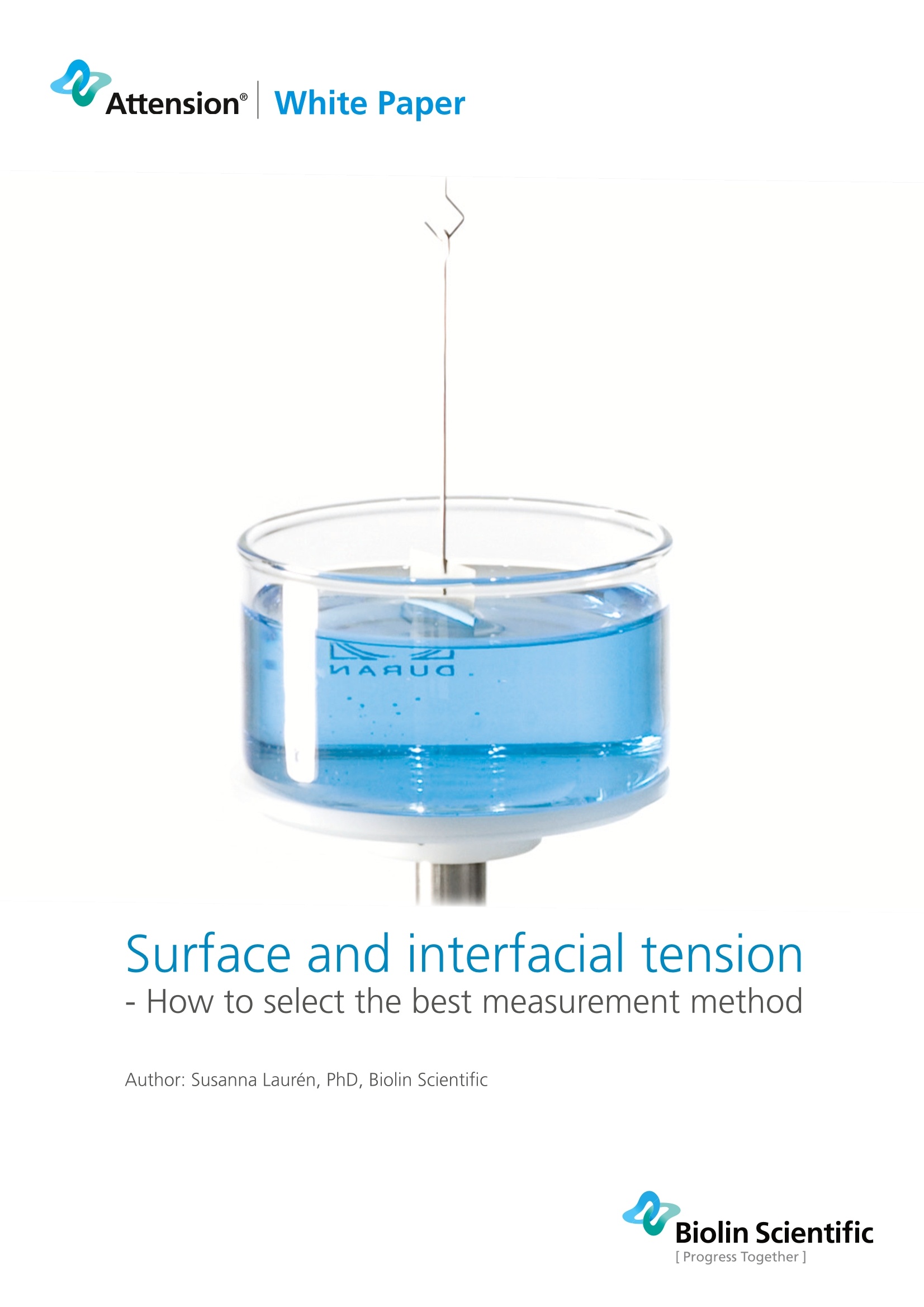
-
2/6
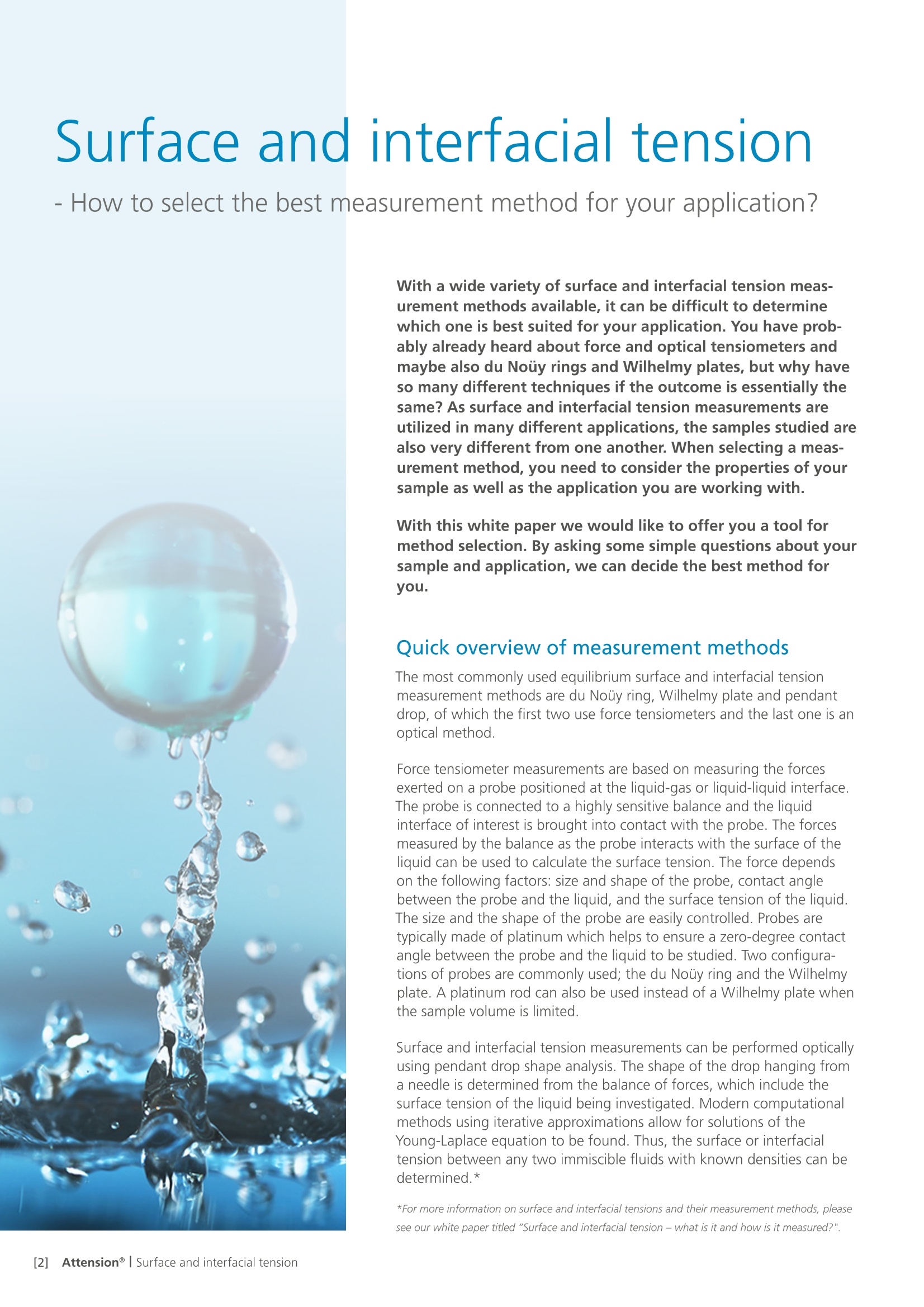
还剩4页未读,是否继续阅读?
继续免费阅读全文产品配置单
大昌华嘉科学仪器为您提供《表面张力和界面张力中测量方法检测方案(接触角测量仪)》,该方案主要用于其他中测量方法检测,参考标准《暂无》,《表面张力和界面张力中测量方法检测方案(接触角测量仪)》用到的仪器有光学接触角测量仪(水滴角测量仪) Theta Flex、光学接触角形貌联用仪。
我要纠错
相关方案


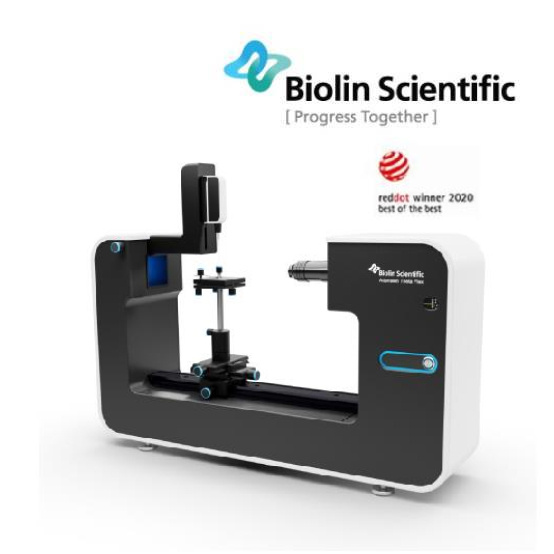

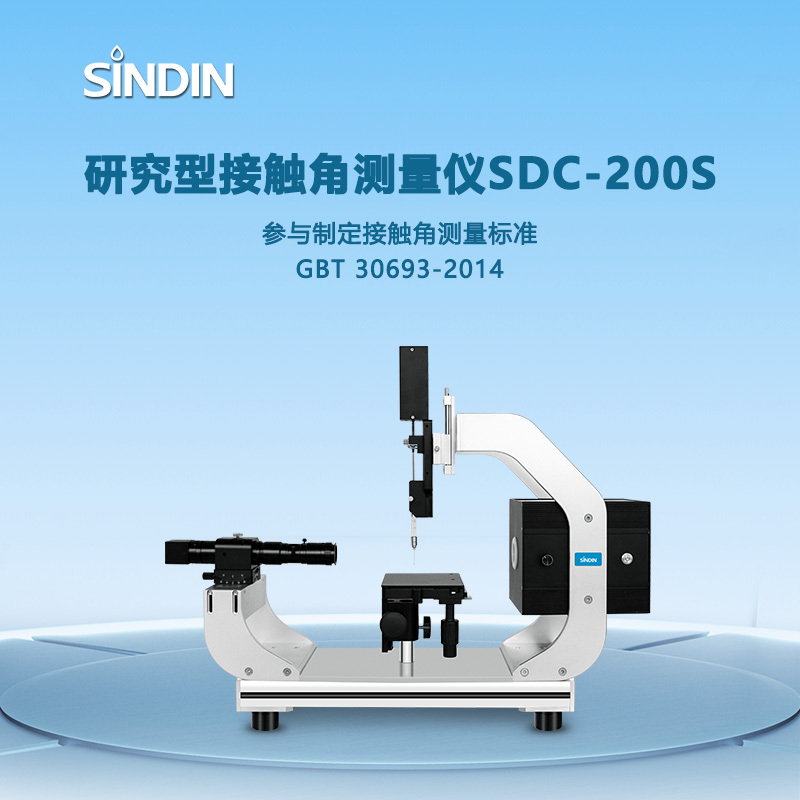
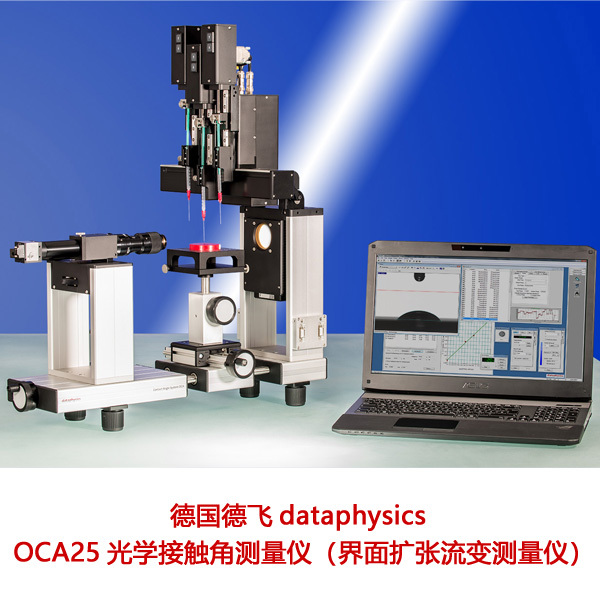
 咨询
咨询